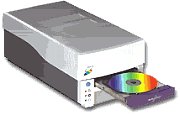How does Thermal Transfer Printing Work?
 The
Rimage CD printer is the most known and reliable thermal transfer
printer on the market today. The
Rimage CD printer is the most known and reliable thermal transfer
printer on the market today.
The thermal transfer
process applies sufficient pressure with just the right amount
of heat to print on the surface of a CD or DVD. The thermal
transfer printer presses the ribbon against the surface and
applies heat. This develops a line of contact between the
surface and the resin coated (ink) side of the ribbon. The
disc and the ribbon move in unison past the stationary print
head.
During the thermal
transfer process, each color is applied separately and the
surface of the disc could have a ridge or step at the edge
of a color. The surface of a disc will have steps at the object
boundaries if: screened with spot color objects a spot color
object is printed over another where spot color coating thickness
is unequal. These steps are very minuscule and most often
will not be noticed.
It is best to print
a sample first and check to assure the output is acceptable.
If not, you can adjust the artwork and then reprint until
your desired affect is achieved.
Some CD or DVD
surfaces are too rough for thermal printing. These surfaces
include ink-jet printable, process colored, or textured silk
screen CD-R surfaces. CD-R surfaces that are inherently smooth
enough for successful thermal printing are spin coated lacquer
(blank discs); silk-screened single ink (major manufacturer's
matte gold, white, or silver thermally printable discs); and
offset printed discs.
Thermal printing
is a great substitution to the more expensive silk-screening.
While you do not get that silkscreened look, you do get a
professional looking quality print.
|
